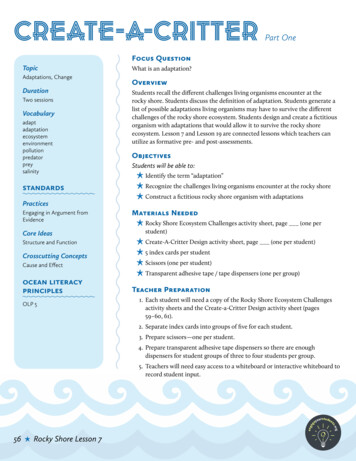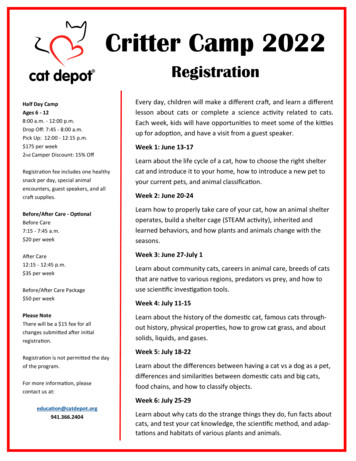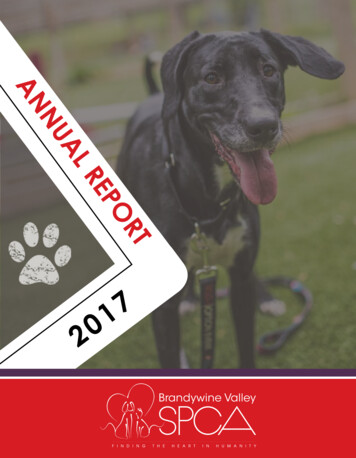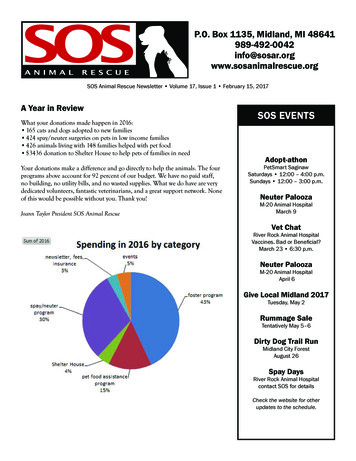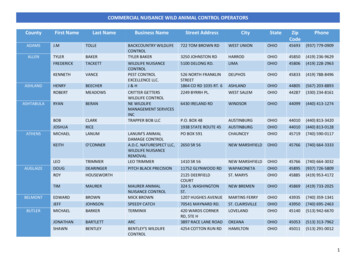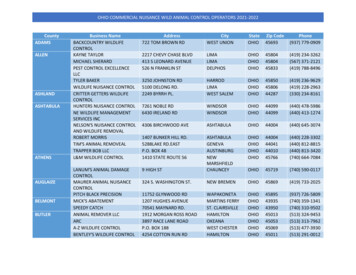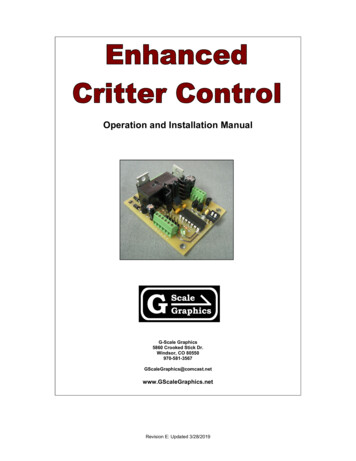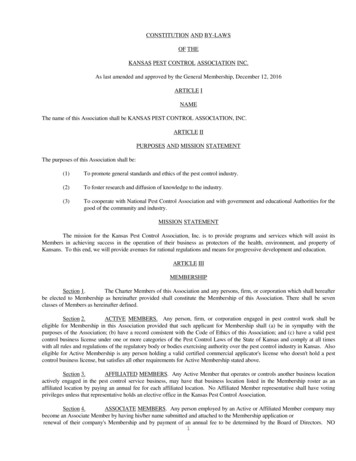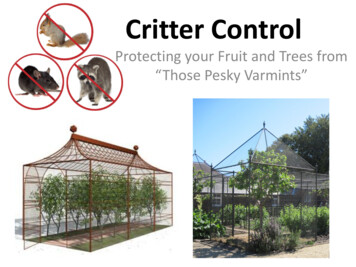
Transcription
Critter ControlProtecting your Fruit and Trees from“Those Pesky Varmints”
Critter ControlMammals: Gophers – Rats – Squirrels – Raccoons – Rabbits Birds Snails Ants Some common insects and bugs Some common diseases
Pocket Gophers Five species of pocket gophers are found in California Although they are sometimes seen feeding at the edgeof an open burrow, pushing dirt out of a burrow, ormoving to a new area, gophers for the most part remainunderground in the burrow system. Gophers usually live alone within their burrow system,except for females with young or when breeding, andmay occur in densities of up to 16 to 20 per acre. Favorite fruit trees that are frequently attacked bygophers include figs and bananas. They will, however,attack almost any fruit tree.
Pocket Gophers Mounds of fresh soil are the best sign of gopher presence. Mounds are formed as the gopher digs its tunnel and pushesthe loose dirt to the surface. Typically mounds are crescentor horseshoe-shaped when viewed from above. The hole,which is off to one side of the mound, is usually plugged. One gopher may create several mounds in a day. Most commonly they feed on roots and fleshy portions ofplants they encounter while digging. Sometimes they feedaboveground, venturing only a body length or so from theirtunnel opening. Burrow openings used in this manner arecalled "feed holes." They are identified by the absence of adirt mound and a circular band of clipped vegetation aroundthe hole.Gopher mound showing direction ofburrow and where soil was pushed outof the hole (arrows in a "fan" pattern).
Gopher Control Repellants There are a few repellents registered by EPAfor gopher control that contain castor oil.Some predator odors have been tested asgopher repellents, but cannot be currentlyrecommended. Commercially-available sonic devises areclaimed to repel pocket gophers. There is,however, no scientific supporting evidence. The plants known as caper spurge, gopherpurge, or mole plant (Euphorbia lathyrus)and the castor-oil plant (Ricinus communis)have been promoted as gopher repellents,but there is no evidence of theireffectiveness. In addition, these are notrecommended as they are both poisonousto humans and pets.
Critter Repellants There is an ever increasing number of both sonic and “scent” repellantsthat are being advertised to keep away everything from gophers to rats andmice, squirrels, rabbits, deer, dogs and cats, snakes and bugs. There is no independent, scientific evidence that ANY of these are effective.
Gopher ControlThe Rodenator
Gopher Control Products Traps are often the most effective. Use in snap traps in pairs and placeback to back. Place box traps in each tunnelTraps, Baits and Gases
Gopher Control Products Baits work well if used properly andare often the most “convenient”. Abait injector tool is a useful tool. Gases are most effective when thesoil is moist. Gases are often theleast effective of these options. Blow the gas into the gopher tunnelwith a blower or a Shop Vac toincrease the effectiveness of thesmoke.Baits and Gases
Gophers Baskets Young trees can be protected fromgopher damage by planting the tree ina large aviary wire basket. The wire should have openings nolarger than ½” and the top edge of thebasket should extend at least 2”-3”above the surface of the soil or mulch.
Tree Rats Tree rats are especially fond of avocados and citrus and often eat fruitthat is still on the tree. When feeding on a mature orange, they make asmall hole through which they completely remove the contents of thefruit, leaving only the hollowed out rind hanging on the tree. The rind ofa lemon is often eaten, leaving the flesh of the sour fruit still hanging.
Tree Rats / Roof Rats Roof rats are very agile climbers and usually live and nest above ground in shrubs,trees, and dense vegetation such as ivy. Roof rats eat a wide variety of foods, but their food preferences are primarily fruits,nuts, berries, slugs, and snails. Roof rats routinely travel up to 300 feet for food. They may live in the landscapingof one residence and feed at another. They can often be seen at night runningalong overhead utility lines or fence tops.
Traps Since rats prefer to stay off the ground, they like to run along the stringer boards of fencesand the horizontal support poles of chain link fences. Traps can be nailed directly to thehorizontal stringer board of wooden fences. To secure rat traps to horizontal poles of chain link fences, put an eye screw on each side ofthe trap and use several heavy rubber bands or zip tie to hold the trap to the pole. Traps should be set only from dusk until dawn to avoid killing non-target animals activeduring the day. Roof rats are nervous and cautious of new objects in their environment, so leave traps in thesame location for at least a week before moving them. It is a good idea to bait the trap, but not set the trap for several days. After baiting the trapfor 3-5 days, set the trap. This will increase the success rate for trapping.
Rat Baits Anticoagulant RodenticidesRodents poisoned with anticoagulants die from internal bleeding.Because anticoagulant baits are slow in action (several daysfollowing the ingestion of a lethal dose), the target animal is unableto associate its illness with the bait eaten. Therefore, bait shynessdoes not occur. This delayed action also has a safety advantage because it providestime to administer the antidote (vitamin K1) to save pets, livestock,and people who may have accidentally ingested the bait. Grain-based baits in a loose meal or pelleted form are available inbulk or packaged in small, plastic, cellophane, or paper "placepacks". These packets keep bait fresh and make it easy to place baitsinto burrows, walls, or other locations. Rodents will gnaw into thesebags to feed on acceptable baits. Pelleted baits can more easily be carried by rats to other locations.Such hoarding of food by rats is not uncommon and may result inbait being moved to places where it is undetected or difficult torecover. In some cases these baits may then become hazardous tonontarget species. Anticoagulant baits have also been formulated into wax andextruded blocks. These are generally less readily accepted byrodents.
Rat BaitsNon-anticoagulant RodenticidesZinc phosphide has been used extensively in the control of rodents. When zinc phosphide comes intocontact with dilute acids in the stomach, phosphine (PH3 ) is released. Rats and mice that ingest lethal amounts of bait usually succumb overnight. Because zinc phosphide is not stored in muscle or other tissues of poisoned animals, there is nosecondary poisoning with this rodenticide. The bait, however, remains toxic up to several days in the gut of a dead rodent. Other animals canbe poisoned if they eat enough of the gut content of rodents recently killed with zinc phosphide. Bait shyness can be a problem; so prebaiting is recommended or necessary for achieving good baitacceptance.Cholecalciferol (Vitamin D3) is a single-dose or multiple-dose rodenticide that causes mobilization ofcalcium from the bone matrix to plasma and death from hypercalcemia. Time to death is 3 to 4 days after ingestion of a lethal dose. As the toxicant is slow-acting, baitshyness apparently does not occur. No secondary poisoning for birds of prey. Dogs are very susceptible to poisoning by vitamin D3
Use of Poisons If poison baits are used outdoors, they mustbe placed in a tamper-resistant bait station.All rodenticide labels state that it is illegal toplace any poison rodenticide baits wherethey are accessible to children, pets,livestock, or wildlife, unless the bait iscontained in a secured, tamper-resistantbait station. The practice of wiring poison bait blocks tobranches of trees is illegal and has causedthousands of cases of accidental poisoningof dogs and wildlife each year.
Ground Squirrels Ground squirrels damage many fruit trees and ornamental plants bygnawing bark, girdling trunks, eating twigs and leaves, and burrowingaround roots. Poison bait is commonly used to control ground squirrels.Squirrel bait can be quite toxic topets and non-target animals andmust be used with a bait station toreduce the risk of accidentalpoisoning.
Make a PVC Bait StationPut a lip or elbowpiece on the end ofthe bait station toprevent squirrels fromtracking bait outsidethe station.
Live Traps Raccoons, opossums, squirrels and other critters can take advantage ofyour hard work and eat your fruit. These animals can be trapped andrelocated or destroyed by using live catch traps. These traps may be purchased on line or at many feed stores.
Cone Baffle Guards Cone baffles can exclude rats and other climbing pests from getting into your trees. Baffles can be made out of a variety of materials. Lower branches must be pruned away and tree must not touch anything that wouldallow pests to gain access into the tree.
How to Make a Conical Baffle
Rabbits Rabbits can damage or kill youngtrees by girdling the bark aroundthe trunk of the tree. They willoften eat the lower foliage orgnaw on lower branches. Trunk protectors made of wire mesh or plastic are often used to protect youngtrees from rabbit damage.
Birds Many birds eat insects in the garden, however, some also eat ripening fruit. Birds should be discouraged from you fruit, but never harmed or killed. There areseveral products available to protect your crop from birds. These products vary in their effectiveness.Scare TapeOwl and hawk decoys shouldbe moved around frequently.
Bird Netting is the most effectiveway to protect your fruit from birddamage. The net must be staked to theground or closed around the treetrunk or tree limbs to keep the birdsaway from your fruit. Be sure to remove the netting assoon as the fruit is harvested. Thisprevents the tree from growingthrough the netting and beingdamaged when the net is finallyremoved.Birds
Motion Activated Sprinkler Animal Repellent Motion-activated scarecrow sprinklers automatically detect animalsas they approach. Repels animals with short bursts of water.
Snails The brown garden snail (Helix aspersa) is the most commonsnail causing problems in California gardens; it wasintroduced from France during the 1850s for use as food. The white garden snail, Theba pisana, is the worst potentialagricultural pest of the helicid snails introduced to NorthAmerica. The snails were found and identified in August1985 in San Diego, California, at several localities in about a10 square mile area Snails are excellent climbers and often will also feed on foliage and fruit of sometrees; citrus are especially susceptible to damage.
Snail Control Most snail and slug baitshave mateldehyde as themain active ingredient. Baits containing Iron Phosphate kill snails and slugsbut are of very low risk to dogs, cats, wildlife andpeople. They are also less toxic to fish thanconventional snail baits. Mateldehyde is very toxicto mollusks as well asdogs, cats, wildlife, fishand people. As these baits break down they become plantnutrients in the form of iron and phosphorous.
Snail and Slug Control Snails and slugs cannot crawl over copper.
Decollate Snails These predatory snails eat the eggs and young of the brown gardensnail. They are not effective against large snails or slugs. They may attack young seedlings or fallen fruit. The do not climb trees. Used together with copper banding on trees,decollate snails can be effective in reducing pest snail populations.Snail Baits will kill Decollate snails!
Ants Some species of ants "farm" aphids, mealybug, soft scale,whitefly or other honeydew producing insects. The ants eat thehoneydew that these insects secrete. At the same time, they protect these insects from naturalenemies. Controlling the ants in your fruit orchard will go a long way inreducing other insect pest problems on your fruit trees.
Pest Control - Ants Ants can be kept out of trees by banding treetrunks with sticky substances such asTanglefoot. Trim branches to keep them from touchingstructures or plants so that ants are forced toclimb up the trunk to reach the foliage. Protect young or sensitive trees frompossible injury by wrapping the trunk with acollar of heavy paper, duct tape, or fabric treewrap and coating this with the stickymaterial. Check the sticky material every few days andstir it with a stick to prevent the materialfrom getting clogged with debris and deadants, which will allow ants to cross.
Ants When properly used, baits are more effective andsafer than sprays or granules to control ants. Bait products must be slow-acting so that theforaging ants have time to make their way back tothe nest and feed other members of the colonybefore they are killed. Different attractants are more effective againstdifferent species of ants and at different times ofthe year. In the case of Argentine ants, sweet baits areattractive year-round. Control with baits may take several weeks ormore to be complete.
Sooty Mold Many sucking insects producelarge quantities of a stickyexcrement known as honeydew. Honeydew often turns black withthe growth of a sooty moldfungus. Sooty mold blocks sunlight andreduces photosynthesis. Although sooty mold does notdirectly harm the tree, it canweaken the tree and affect fruitproduction by blocking sunlightand reducing the trees ability toproduce food.
Soaping for Healthy Trees Soaps help to clean your trees and removehoneydew, sooty mold, and dirt and dust. To clean trees, use a hose end dial-a-mix typesprayer. Use 2 tsp. soap per gallon of water. Soaps also dry out (desiccate) many softbodied insects. Most soft bodied insects canbe controlled by using insecticidal soaps. Complete coverage is necessary foreffectiveness with soaps as well as with allcontact pesticides. Thorough and completecoverage can be accomplished with “soaps”without the risks associated with mostpoisons. For control of insects, washing trees once perweek for three consecutive weeks is oftennecessary. Scale insects are not effectively controlledby insecticidal soaps.
Some common insects and bugs
Aphids Aphids affect nearly all fruit trees. They occur primarily on young foliage and shoot tips. Large populations of aphids cause curling, yellowing, and distortion of leaves and stuntingof shoots. This may affect growth to the point of hampering the development of fruitingwood and tree development. Aphids have many generations a year. When the weather is warm, many species of aphidscan develop from newborn nymph to reproducing adult in 7 to 8 days. Because each adultaphid can produce up to 80 offspring in a matter of a week, aphid populations can increasewith great speed. High levels of nitrogen fertilizer favor aphid reproductionDamage caused by Green Peach Aphids
Mealybugs Mealybug females feed on plant sap, normally in roots or other crevices. They attachthemselves to the plant and secrete a powdery wax layer (therefore the namemealybug) used for protection while they suck the plant juices. Some species of mealybug lay their eggs in the same waxy layer used for protection inquantities of 50–100; other species are born directly from the female.
Whitefly Whitefly feed onplant sap, normallyon the underside of aplants leaves. Whiteflies and theirwaxy deposits mayoccur on both upperand lower leafsurfaces. Eggs areoften laid among thewax deposits.Giant WhiteflyWoolly Whitefly Common on citrus andtropical guava
Asian Citrus Psyllid The Asian citrus psyllid, is a tiny (1/8 inch inlength) mottled brown insect that is about the sizeof an aphid. It attacks citrus and very closely relatedornamental plants in the family Rutaceae (mockorange, Indian curry leaf, orange jasmine andother Murraya species). Asian citrus psyllid arrived from Mexico and wasdetected in San Diego on September 2nd 2008near the South Bay Terrace area of San Diego. Adults feed with their heads down, almosttouching the surface of the leaf. Because of theshape of their heads, their bodies are lifted toapproximately a 45-degree angle. The more serious damage that this insect causes isin carrying and transmitting the bacteria thatcause Huanglongbing (HLB or citrus greening)disease. This bacterial disease is transmitted tohealthy trees by the psyllid after it feeds oninfected plant tissue. Contact your local Dept. of Agriculture if yoususpect you have this insect on your fruittrees!
Avocado Lacebug and Persia MiteAvocado Lacebug Lace bugs suck leaf sap. Leaf stipplingand bleaching from feeding oninfested leaves can become veryobvious by late summer. Adults and nymphs also foul leaveswith specks of dark, varnishlikeexcrement.Persia Mite Most damaging to Hass, Gwen, and a fewother varieties. Esther, Pinkerton, and Reedare of intermediate susceptibility. The Bacon,Fuerte, Lamb Hass, and Zutano varieties aremuch less affected. Persea mites feed and reproduce mostlybeneath webbed patches or silk-covered"nests.“ All life stages of both insects have several generations a year and can be presentthroughout the year on avocados. High populations of either insect cause premature leaf drop and defoliation. Defoliationleads to sunburned bark and fruit, aborted or dropped fruit, and severely stressed trees,which later reduces yields.
Pear Sawfly (Pear Slug) Host specific. Plants commonlyattacked: Pears, plums, cherry. Larvae feed on leaves causing a“windowing” effect. Damage may cause reduced vigor fromloss of leaves.
Pest ControlAll of the insects that were just discussed are soft bodied insectsand can be controlled using insecticidal soaps as well as a widevariety of organic and non-organic insecticides. Most pest control products used on fruit trees are contact killers.They kill what they touch. The key to successfully using pest control products are tobe complete and thorough with your applications and to beconsistent with your follow up applications!
Scale InsectsRed scale Red scale has a thin, circular,leathery covering over the soft,flattened, shield shaped, creamyyellow insect. The reddish-brownscale cover of the adult female isabout 2 mm across. Red scale is an armored scale anddoes not produce honeydew. This is a common pest on citrus. Itcan occur on leaves, fruit andstems. Soft ScaleSoft scales can be smooth, cottony, orwaxy and are 1 4 inch long or less.They are usually larger and morerounded and convex than armoredscales. Soft scales feed in the fluid-conductingphloem tissue of the plant and excreteabundant honeydew, which is sugarywater that drips from their bodies. Soft scales infest leaves and twigs butrarely feed on fruit.Brown ScaleBlack Scale
Horticultural Oils Oil sprays are used to suffocate insects. They are fairlyeffective against scale insects. Trees should be washed thoroughly before applying oil sprays.Wash trees once a week for two to three weeks prior to applyingoils. Oil sprays should not be applied when temperatures are over 85degrees.F. Apply oils no more frequently than once per month astrees can be damaged or defoliated if applied more often!
Citrus Leafminer Citrus leafminer larvae feed by creating shallow tunnels, or mines, inyoung leaves of citrus trees. It can survive as a larva only in thetender, young, shiny leaf flush of citrus and closely related species.Older leaves that have hardened off are not susceptible unlessextremely high populations are present. Mature trees that have a dense canopy of older foliage to sustainthem can tolerate damage on new leaves with negligible effect ontree growth and fruit yield. The flush growth of citrus trees attacked by leafminer will lookunsightly, but often the best course of action is to leave it alone andlet the natural enemies of the citrus leafminer feed on and parasitizethe larvae in the mines. Young trees may experience a reduction in growth. However, evenyoung trees with heavy leafminer populations are unlikely to die.
Citrus Leafminer Summer heat in the inland areas of California seems to suppress leafminer populations, butin cooler coastal areas, the insect population may remain high from summer through fall. Very young trees do not have much mature foliage and they produce more flush year-round,thereby supporting larger citrus leafminer populations. On very young trees, chemicalcontrol may be recommended.Pheromone trapsattracts the male insectwhere he is caught inthe trap. When insectsbegin to appear, beginspray applications forinsect control. Azadirachtin (Neem) or spinosadshow some efficacy against larvaeand are relatively safe for naturalenemies. The residues do not lastvery long, and these insecticidesmight need to be reapplied every 7 to14 days. Spinosad products are oftenlimited to 6 times per season. Imidacloprid provides the longestperiod of control, 1 to 3 months.Imidacloprid should only be appliedonce a year. Removing blossoms before they openon young trees will prevent honeybee exposure to imidacloprid in thenectar/pollen.
Green Fig Beetles Large grubs (larvae) are frequently found incompost piles and in soil that is rich in organicmaterial. Adult fig beetles frequently attack ripening figsand other soft fruit in large numbers and candestroy your crop of fruit. Traps hung intrees duringthe summercan helpreduce FigBeetlepopulationsand can help toreduce damageto the crop.
Codling Moth The larvae of the codling moth (Cydia pomonella) is thecommon apple worm. It attacks apples, pears, quince,walnuts, and other tree fruits. Codling moth adults are about 1/2 to 3/4 inch long withmottled gray wings that are held tentlike over theirbodies. Their appearance blends well with most tree bark,making them difficult to detect. The larvae pupate inside their cocoons in early spring andemerge as adult moths mid-March to early April. After mating each female deposits 30 to 70 tiny, discshaped eggs singly on fruit, nuts, leaves, or spurs. After the eggs hatch, young larvae seek out and bore intofruit or developing nuts.
Codling Moth After completing development they leave the fruit and drop from the trees tosearch out pupation sites and continue the life cycle in the soil or on debris underthe tree; some crawl back up the tree to pupate in bark crevices. The rate of development will vary with temperature, proceeding more rapidly inwarmer weather and climates. Depending on the climate, codling moth can have two, three, and sometimesfour, generations per year. Trapping the adults can help to control this pest. Traps can also helptime pesticide applications. BT and spinosad are somewhat effectiveif applied before the larvae chews into the fruit.
Some common diseases
Powdery Mildew Fruiting plants affected by PowderyMildew include: Apple, Quince,Stone Fruit, Grape, Caneberries,Strawberry, Mango, Papaya. Different powdery mildew fungicause similar symptoms. Does not require moist conditionsto establish & grow. Likes warmtemperatures. Attacks new growth, buds, shoots,flowers, leaves & fruit.
Rust Fruiting plants affected byRust: Nectarine, Peach,Caneberries. Cankers appear as blistersor small splits in bark. Leaf lesions occur spring,summer & fall. May causedefoliation. Lesions may occur onfruit. The fungus survives in twig cankers or on other host parts. Airborne spores depend on wetness for infection. Infections of young twigs and leaves are the most common symptoms, but in California,fruit infections may be a major component of the disease as well.
Scab Fruiting plants affected byScab include: Apple, Peach,Pear. Favors coastal areas wherespring & summers are cool &moist. Apple leaves puckered, blackcircular spots on uppersurface, velvety spots onlower. Scabby areas on fruit occurwhen fruit ½ grown & startnear stem. Fruit may bestunted, misshapen or crack. Cankers occur on stems ofpeach.
Botrytis (Gray Mold) Fruiting plants affected by Botrytis include: Stone Fruit,Caneberries, Grape, Citrus, Guava, Strawberry, many others. Infects flower petals, young leaves & especially fleshy fruit.Touching fruit spread disease. Spores are spread in dust-like clouds Likes high humidity & moisture. Favors cool – warm spring &summer rainy weather. Occurs at temperatures of 32 –80 degrees. Maintain good air circulation and sanitation! Topping or headingtrees can result in poor air circulation and can promote thisdisease!
Fungicides There are many types offungicides available forcontrolling diseases on fruittrees. These can be organic,inorganic, or synthetic and areavailable in many forms:liquids or powders;concentrates or ready to use. Bacillus subtilis is a bacterium thatis used as a fungicide. It is effectiveagainst a range of bacterial and fungaldiseases. Approved for Organic use/OMRIcertified. Controls common diseases of gardenplants including black spot, powderymildew, anthracnose, bacterial spot, leafblight, rust, gray mold, scab and more.
Fire Blight Fruiting plantsaffected by FireBlight are: Apple,Pear, Quince andLoquat
Fire Blight Fire blight, caused by the bacterium Erwiniaamylovora, is a common and frequently destructivebacterial disease of pome fruit trees. Pear and quincetrees are extremely susceptible. Fire blight infections can destroy limbs and even entireshrubs or trees. Disease symptoms can appear as soon as trees beginactive growth. The first sign is a watery, light tanbacterial ooze that exudes from branch, twig, or trunkcankers . The ooze turns dark after exposure to air,leaving dark streaks on branches or trunks. Cankers may be inconspicuous and infections may notbe noticed until later in spring when flowers, shoots,and/or young fruit shrivel and blacken.
Fire Blight New infections usually first enter through the flowers. Infected flowers and flowerstems wilt and turn black on pear trees, whereas on apple trees they turn brown. Blight infections often move into twigs and branches from infected blossomclusters, causing small shoots to wilt, forming a crook at the end of each infectedshoot. Eventually the infected portion of the shoot turns black. Dead, blackened leavesand fruit cling to branches throughout the season, giving the tree a scorchedappearance, hence the name "fire blight."
Fire Blight The bacteria can be transmitted to nearby blossoms or succulent growing shoots bysplashing rain or insects, especially honey bees. Injuries caused by wind, hail, or insectfeeding to succulent tissues are easily invaded by fire blight bacteria. Ideal conditions for infection, disease development, and spread of the pathogen are rainyor humid weather with daytime temperatures in the range of 75 to 85 F, especially whennight temperatures stay above 55 F. Once fire blight bacteria enter the blossoms, they may cause only a localized infection andeventually die, or they may move into the twigs and branches. Fire blight bacteria that survive generally do not move through the bark uniformly butinvade healthy wood by moving in narrow paths up to 1-1/2 inches wide in the outer barkahead of the main infection. These long, narrow infections may extend 2 to 3 feet beyondthe edge of the main infection or canker. Vigorously growing shoots are the most severely affected; therefore, conditions thatfavor rapid shoot growth, such as high soil fertility and abundant soil moisture, increasethe severity of damage to trees.
Fire Blight Control Eliminate fire blight infections by pruning out diseased branches. Always cut an infectedbranch at least 8 to 12 inches below the visible injury or canker. If a fire blight infection occurs on a trunk or major limb, the wood can often be saved byscraping off the bark down to the cambium layer in infected areas. When scraping, look forlong, narrow infections that may extend beyond the margin of the canker or infection site. Ifany are detected, remove all discolored tissue plus 6 to 8 inches more beyond the infection.If the limb has been girdled, scraping will not work and the whole limb must be removed. To avoid spreading bacteria during pruning, dip or spray the pruning tool before each cutwith a 10% solution of bleach (one part bleach to nine parts water). A very weak (about 0.5%) Bordeaux mixture or other copper fungicide applied severaltimes as blossoms open can reduce new infections, but will not eliminate all new infectionsnor those already existing in wood. The number of applications needed depends on theblooming period. Once blossoms begin to open, make the first application when the averagetemperature exceeds 60 F. Apply at 4- to 5-day intervals during periods of high humidity anduntil late bloom is over. For pear trees, this may mean five to twelve applications per season.
Critter Control
Gopher Control - Repellants There are a few repellents registered by EPA for gopher control that contain castor oil. Some predator odors have been tested as gopher repellents, but cannot be currently recommended. Commercially-available sonic devises are claimed to repel pocket gophers. There is, however, no scientific supporting evidence.
